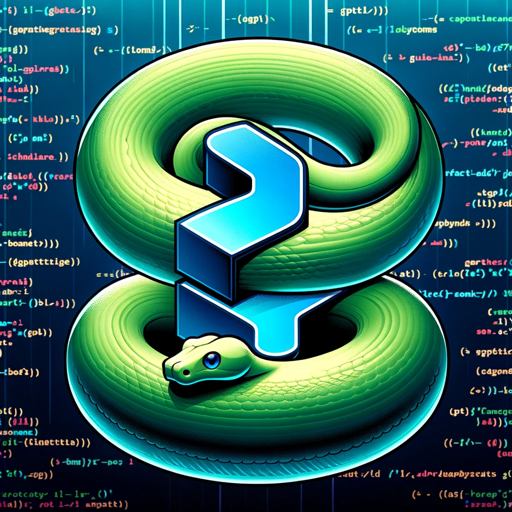Python/SQL-Python/SQL coding and database management
AI-powered Python and SQL toolkit
Can you help me with this error?
What's a unique SQL optimization trick?
I need a quirky but detailed explanation of this Python code.
How would you humorously optimize this SQL query?
Related Tools
Load More
SQL Generator
Advanced SQL assistant and query generator. Write clean SQL queries and become a much faster developer.

Python Code Expert
Develop Python applications that are efficient, maintainable, testable, performant, and robust. Excels at OOP design, error handling, documentation, logging, and much more. Includes unit tests written in pytest for all code snippets.

Python Developer
Experienced Python Developer offering expert coding advice and debugging help

SQL Helper
Assists with SQL queries, database optimization, and explaining SQL concepts.

Python Expert
Practical Python tutor with a focus on real-world applications and hands-on learning with projects.

Python & SQL Translator
Expert in Python, SQL, and optimizing coding solutions, with a witty edge.
20.0 / 5 (200 votes)
Introduction to Python/SQL
Python/SQL is designed to bridge the gap between two of the most powerful tools in modern computing: Python, a versatile and widely-used programming language, and SQL, the standard language for querying and managing databases. The purpose of Python/SQL is to provide an integrated platform where users can harness the strengths of both Python and SQL to perform data analysis, automate tasks, build applications, and manage databases efficiently. This combination is especially useful for data-driven tasks where Python's scripting capabilities and SQL's database management are both needed. For example, consider a scenario where a data analyst needs to extract data from a large relational database, perform complex data transformations, and then visualize the results. Python/SQL allows them to write SQL queries directly within a Python script, process the data using Python’s libraries like Pandas, and generate visualizations with tools like Matplotlib or Seaborn. This seamless interaction between Python and SQL eliminates the need for context switching between different tools, streamlining the workflow and making the process more efficient.

Main Functions of Python/SQL
Database Connectivity and Querying
Example
Using Python's libraries such as `sqlite3`, `SQLAlchemy`, or `pyodbc`, users can connect to various types of databases, execute SQL queries, and retrieve data directly into Python objects.
Scenario
A data engineer is tasked with extracting data from a PostgreSQL database for further processing. They use Python to connect to the database, run SQL queries to fetch the necessary data, and then use Pandas to clean and transform this data before loading it into a data warehouse.
Data Manipulation and Analysis
Example
Python's powerful libraries like Pandas allow users to manipulate and analyze data retrieved from SQL queries. Users can perform operations like filtering, grouping, and aggregating data.
Scenario
A financial analyst needs to analyze sales data stored in a MySQL database. They query the database to pull the raw sales data, then use Pandas to calculate monthly sales trends, identify key sales drivers, and create a summary report for the management team.
Automation and Scripting
Example
Python scripts can be used to automate repetitive database tasks, such as daily data extraction, transformation, and loading (ETL) processes.
Scenario
An IT administrator is responsible for daily backups of a company's Oracle database. They write a Python script that automatically connects to the database, extracts the necessary tables, compresses them, and stores them in a secure location, all without manual intervention.
Ideal Users of Python/SQL
Data Scientists and Analysts
These users benefit from Python/SQL by being able to combine data extraction, transformation, and analysis in one environment. Python's analytical libraries, in conjunction with SQL's powerful querying capabilities, enable them to perform complex data operations efficiently.
Database Administrators and Engineers
For professionals responsible for managing databases and ensuring their performance, Python/SQL provides a robust platform to automate tasks, monitor database health, and perform batch operations. The integration with Python allows for more sophisticated scripting and automation solutions.

Comprehensive Guide to Using Python/SQL
Visit aichatonline.org for a free trial
Start by accessing aichatonline.org where you can try the Python/SQL tool without needing to log in or sign up for ChatGPT Plus. This platform provides an easy and quick way to explore the tool's capabilities.
Set Up Your Environment
Ensure you have Python installed on your local machine, along with a suitable IDE like PyCharm or VS Code. For SQL, set up a database environment using software like MySQL, PostgreSQL, or SQLite.
Explore Common Use Cases
Use Python for tasks like data analysis, machine learning, web development, and automation. SQL is ideal for managing and querying databases, performing data analysis, and integrating with Python for advanced data handling.
Optimize Your Workflow
Leverage Python libraries such as pandas for data manipulation, SQLAlchemy for database management, and Jupyter notebooks for an interactive coding experience. Combine SQL queries with Python scripts for seamless data processing.
Continuous Learning and Experimentation
Regularly update your skills by following Python and SQL documentation, engaging with community forums, and experimenting with new libraries or databases. This helps in keeping up with best practices and advanced features.
Try other advanced and practical GPTs
更聪明的进击型GPT4
AI-Powered Solutions for Smart Users

Twitter Analyzer
AI-powered Twitter sentiment analysis.

Vue JS Expert
AI-powered Vue.js development expert

Vue Copilot
Your AI-Powered Vue.js Development Partner

News on Demand
AI-Powered News and Forecasts on Demand

Traductor al Francés
AI-powered translations for natural French.

In Traditional Chinese
AI-powered Traditional Chinese Text Solutions
Video Maker
AI-powered video script creation

Image Converter to JPG images
AI-powered image format conversion made easy.

Dr. CHAD AI (A&P Templates) [ Medical Education]
AI-powered A&P templates for education
![Dr. CHAD AI (A&P Templates) [ Medical Education]](https://files.oaiusercontent.com/file-iybfoMIsjHlkseFBFXE3slvb?se=2123-12-22T18%3A16%3A24Z&sp=r&sv=2021-08-06&sr=b&rscc=max-age%3D1209600%2C%20immutable&rscd=attachment%3B%20filename%3DDR%2520CHAD%2520AI%2520FINAL_V3.png&sig=GMD31CyJzyv390PyK%2BZ3FZf7M5ypWncoedsqugvgMB4%3D)
Furqin: The PR Inspector
AI-powered precision for your content.

二次元图片
AI-powered anime character creation

- Data Analysis
- Automation
- Web Development
- Machine Learning
- Database Management
Python/SQL: In-Depth Q&A
How can I integrate Python with SQL?
You can integrate Python with SQL using libraries like SQLAlchemy or SQLite3. SQLAlchemy provides an ORM (Object Relational Mapper) that allows you to interact with the database using Python objects, while SQLite3 is a lightweight database included with Python.
What are the most common use cases for Python/SQL?
Common use cases include data analysis and visualization, web development with Django or Flask, automation scripts, machine learning, and database management tasks such as querying, updating, and maintaining relational databases.
What prerequisites do I need to start with Python/SQL?
To start, you need a basic understanding of programming concepts for Python and knowledge of relational databases for SQL. Installing Python and a database like MySQL or PostgreSQL on your system is also essential.
Can I use Python/SQL for data analysis?
Absolutely. Python’s pandas library allows you to manipulate and analyze data, while SQL enables efficient querying and management of large datasets. Together, they form a powerful toolkit for data-driven tasks.
How does Python handle SQL queries?
Python can handle SQL queries through libraries like pyodbc, SQLAlchemy, or psycopg2. These libraries allow Python to connect to a database, execute SQL queries, and retrieve results, all within a Python script.